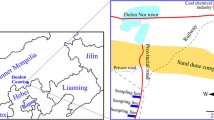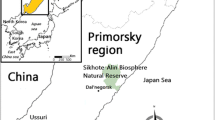Abstract
Total concentrations of Al, Ba, Cd, Co, Cr, Cu, Fe, Mn, Mo, Pb, Sr, Ti, V and Zn in the epiphytic lichen Parmelia sulcata and superficial soils from 60 remote sampling sites in Tuscany (central Italy) were determined to evaluate the contribution of soil to the elemental composition of the lichen. The results showed that in the Mediterranean environment, the trace element content of unwashed lichen samples is greatly affected by soil contamination. However, despite the strong correlations between the concentrations of lithogene elements such as Al, Fe and Ti in P. sulcata, lichen levels of these elements were not at all linearly correlated with their concentrations in the soil, suggesting that dust contamination is highly variable and probably dependent on local site characteristics. All methods evaluated to minimize soil contamination indicated Cu, Pb and Zn as elements of atmospheric origin. However, while levels of Pb were similar to those reported for background areas, moderate pollution by Cu and Zn, probably from fertilizers used in agriculture, was revealed. For elements such as Cd and Mo, identified as atmophile, some uncertainty exists due to the fact that they are essential for lichen metabolism and accumulate intracellularly in lichens; they may therefore occur in soluble form in the lichen thallus.
Similar content being viewed by others
References
Adriano, D. C.: 1986, Trace elements in the terrestrial environment, Springer, Berlin.
Andersen, A., Hovmand, M. F. and Johnsen, I.: 1978, ‘Atmospheric heavy metal deposition in the Copenhagen area’, Environ. Pollut. 17, 133–151.
Baker, D. A.: 1983, ‘Uptake of cations and their transport within the plants’, in: Robb, D. A. and Pierpoint, W. S. (eds.), Metals and micronutrients: uptake and utilization by plants. Academic Press, London, pp. 3–19.
Barazzuoli, P., Guasparri, G. and Salleolini, M.: 1993, ‘Il clima’, in: Giusti, F. (ed.), La storia naturale della Toscana meridionale, Amilcare Pizzi, Cinisello Balsamo, pp. 141–171.
Bargagli, R.: 1990, ‘Assessment of metal air pollution by epiphytic lichens: the incidence of crustal materials and the possible uptake from substrate barks’, Studia Geobot. 10, 97–103.
Bargagli, R.: 1995, ‘The elemental composition of vegetation and the possible incidence of soil contamination of samples’, Sci. Total Environ. 176, 121–128.
Bargagli, R., Brown, D. H. and Nelli, L.: 1995, ‘Metal biomonitoring with mosses: procedures for correcting for soil contamination of samples’, Environ. Pollut. 89, 169–175.
Bargagli, R., Iosco, F. P, D'Amato, M.L.: 1987, ‘Zonation of trace metal accumulation in three species of epiphytic lichens belonging to the genus Parmelia’, Cryptogamie Bryol. Lichénol. 8, 331–337.
Bennett, J. P.: 1995, ‘Abnormal chemical element concentrations in lichens of Isle Royal National Park’, Environ. Exp. Bot. 35, 259–277.
Brown, D. H.: 1976, ‘Mineral uptake by lichens’, in: Brown, D. H., Hawsworth, D. L. and Bailey, R. H. (eds.), Lichenology: progress and problems, Academic Press, London, pp. 419–439.
Brown, D. H.: 1987, ‘The location of mineral elements in lichens; implications for metabolism’, Bibl. Lichemol. 25, 361–375.
Farago, E. F.: 1994, Plants and the chemical elements, WCH, Weinheim.
Fisher, P. J. and Proctor, M. C. F.: ‘Observations on a season's growth in Parmelia caperataand P. Sulcatain South Devon’, Lichenologist 10, 81–89.
Garty, J.: 1993, ‘Lichens as biomonitors for heavy metal pollution’, in: Markert, B. (ed.), Plants as biomonitors. Indicators for heavy metals in the terrestrial environment, VCH, Weinheim, pp. 193–263.
Garty, J., Galun, M. and Kessel, M.: 1979, ‘Localization of heavy metals and other elements accumulated in the lichen thallus’, New Phytol. 82, 159–168.
Gough, L. P., Severson, R. C. and Jackson, L. L.: 1988, ‘Determining baseline element composition of lichens. I. Parmelia sulcataat Theodore Roosevelt National Park, North Dakota’, Water, Air, Soil Pollut. 38, 157–167.
Guevara, S. R., Arribére, M. A., Calvelo, S. and Roman Ross, G.: 1995, ‘Elemental composition of lichens at Nahuel Huapi National Park, Patagonia, Argentina’, J. Radioanal. Nucl. Chem. 198, 437–448.
Hale, M. E.: 1983, The biology of lichens, Edward Arnold, London.
Hale, M. E. and Lawrey, J. D.: 1985, ‘Annual rate of lead accumulation in the lichen Pseudoparmelia baltimorensis’. Bryologist 88, 5–7.
Herzig, R.: 1993, ‘Multi-residue analysis with passive biomonitoring: a new approach for volatile multi-element content, heavy metals and polycyclic hydrocarbons with lichens in Switzerland and the Principality of Liechtenstein’, in: Markert, B. (ed.), Plants as biomonitors. Indicators for heavy metals in the terrestrial environmnt, VCH, Weinheim, pp. 285–328.
Herzig, R., Liebendörfer, L., Urech, M., Ammann, K., Guecheva, M. and Landolt, W.: 1989, ‘Passive biomonitoring with lichens as a part of an integrated biological measuring system for monitoring air pollution in Switzerland’, Intern. J. Environ. Anal. Chem. 35, 43–57.
Knops, J. M. H., Nash, T. H., Boucher, V. L. and Schlesinger, W. L.: 1991, ‘Mineral cycling and epiphytic lichens: implications at the ecosystem level’, Lichenologist 23, 309–321.
Loppi, S.: 1997, ‘Incidence of soil matter to the trace element content of the peripheral and internal parts of lichen thalli’, Micol. Veg. Medit., in press.
Loppi, S., Nelli, L., Ancora, S. and Bargagli, R.: 1997a, ‘Passive monitoring of trace elements by means of tree leaves, epiphytic lichens and bark substrate’, Environ. Monit. Ass. 45, 81–88.
Loppi, S., Nelli, L., Ancora, S, and Bargagli, R.: 1997b, ‘Accumulation of trace elements in the peripheral and central parts of a foliose lichen thallus; Bryologist 100, 251–253.
Lounamaa, K. J.: 1965, ‘Studies on the content of iron, manganese and zinc in macrolichens',Ann. Bot. Fennici 2, 127–137.
Markert, B.: 1992, ‘Presence and significance of naturally occurring chemical elements of the periodic system in the plant organisms and consequences for future investigations on inorganic environmental chemistry in ecosystems’, Vegetatio 103, 1–30.
Mastino, G., Testa, L., Michetti, I. and Ghiara, E.: 1987, ‘Elementi in traccia nel particolato atmosferico in Italia’, Acqua-Aria 1, 17–33.
Nash, T. H. and Gries, C.: 1995, ‘The use of lichens in atmospheric deposition studies with an emphasis on the Arctic’, Sci. Total Eviron. 160, 729–736.
Nieboer, E., Richardson, D. H. S. and Tomassini, F. D.: 1978, ‘Mineral uptake and release by lichens: an overview’, Bryologist 81, 226–246.
Olmez, I., Cetin Gulovali, M. and Gordon, G. E.: 1985, ‘Trace element concentrations in lichens near a coal-fired power plant’, Atmos. Environ. 19, 1663–1669.
Ormrod, D. P.: 1984, ‘Impact of trace element pollution on plants’ in: Treshow, M. (ed.), Air pollution and plant life, John Wiley and Sons, Chichester, pp. 291–319.
Prussia, C. M. and Killingbeck, K. T.: 1991, ‘Concentrations of ten elements in two common foliose lichens: leachability, seasonality and the influence of rock and tree bark substrates’, Bryologist 94, 135–142.
Puckett, K. J.” 1985, ‘Temporal variation in lichen element levels’, in Brown, D. H. (ed.), Lichen physiology and cell biology, Plenum Press, New York, pp. 211–225.
Puckett, K. J. and Finegan, E. J.: 1980, ‘An analysis of the element content in lichens from the Northwest Territories, Canada’, Can. J. Bot. 58, 2073–2089.
Quevauviller, P., Van Renterghen, D., Muntau, H. and Griepink, B.: 1993, ‘Intercomparison to improve the quality of trace element determination in lichens’, Intern. J. Environ. Anal. Chem. 53, 233–242.
Rose, A. W., Hawkes, H. E. and Webb, J. S.: 1979, Geochemistry in mineral exploration, Academic Press, London.
Shacklette, H. T. and Boerngen, J. G.: 1984, Element concentrations in soils and other superficial materials of the conterminous United States, USGS N. 1270, Washington, U.S.A.
Società Italiana della Scienza del Suolo: 1985, Metodi normalizzati di analisi del suolo, Edagricole, Bologna.
Witting, R.: 1993, ‘General aspects of biomonitoring heavy metals by plants’, in: Markert, B. (ed.), Plants as biomonitors. Indicators for heavy metals in the terrestrial environment, VCH, Weinheim, pp. 3–27.
Author information
Authors and Affiliations
Corresponding author
Rights and permissions
About this article
Cite this article
Loppi, S., Pirintsos, S.A. & De Dominicis, V. Soil Contribution to the Elemental Composition of Epiphytic Lichens (Tuscany, Central Italy). Environ Monit Assess 58, 121–131 (1999). https://doi.org/10.1023/A:1006047431210
Issue Date:
DOI: https://doi.org/10.1023/A:1006047431210




